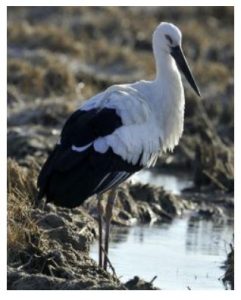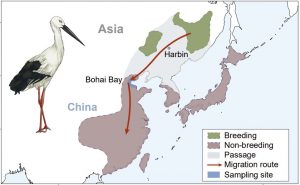A visit from the Oriental Stork
This week in GigaScience we published a new genomic analysis of the endangered Oriental Stork, bringing good news: The population’s genetic health is still surprisingly strong, with high genetic diversity and low levels of inbreeding.
Climate change, forest wildfires, hunting and the expansion of agriculture, industry and other human activities threaten the Oriental Stork (Ciconia boyciana), which is listed as endangered by the World Conservation Union.
 In the new Gigascience paper, the authors collected genomic information on the species and compared the findings with other migratory and non-migratory birds. Lead by a research team at Northeast Forestry University (China) with collaborators from Harbin, Shenyang, Zhejiang University, and Inner Mongolia, the scientists first assembled a high-quality reference genome of the Oriental Stork and sequenced the genomes of 29 wild Oriental storks and 15 captive individuals. In addition, they also collected whole genome sequencing data from one captive individual in Japan and the United States for comparative analysis.
In the new Gigascience paper, the authors collected genomic information on the species and compared the findings with other migratory and non-migratory birds. Lead by a research team at Northeast Forestry University (China) with collaborators from Harbin, Shenyang, Zhejiang University, and Inner Mongolia, the scientists first assembled a high-quality reference genome of the Oriental Stork and sequenced the genomes of 29 wild Oriental storks and 15 captive individuals. In addition, they also collected whole genome sequencing data from one captive individual in Japan and the United States for comparative analysis.
A fascinating stork
Dr Tianming Lan, one of the scientists involved in the study, explains why he is so fascinated by this species, which breeds in the Russian Far East and Northeast China and migrates to the Bohai Bay and Poyang Lake in the lower reaches of the Yangtze River in autumn to overwinter:
“The Oriental stork is one of the most elegant birds both in flight and on the ground that I have ever seen, and this bird has many fascinating features, including its long distance migration and ‘beak clacking’ communication. However, this beautiful bird is an endangered species, which stimulated us to carry out this conservation genomic study.”
High diversity in small numbers
One aspect to worry about in all endangered species is a potentially low level of genetic diversity, and accordingly high levels of inbreeding. That can signal imminent doom for a species: A loss of diversity and inbreeding can increase genetic disorders and reduce immunity and overall health, making already dwindling populations even more vulnerable to extinction.
However, the genomic data reveal that although the number of Oriental Storks has decreased significantly in the last century, the genetic diversity of wild and captive populations is still high, and the inbreeding level is low. For the Oriental Stork, the outlook is therefore better than for many other endangered species, from a genetics perspective at least: The findings indicate that the wild population, with appropriate conservation intervention, may have a high potential for genetic rejuvenation.
Dr Lan is quite optimistic:
“With the reduction of human interference and damage to their habitats and migration routes, we expect a fast population recovery”.
The authors speculate that the migratory lifestyle might help in keeping genetic diversity high within the whole population, as compared to other endangered species that are geographically isolated.
Understanding stork migration
To better understand the migratory behavior of the Oriental Stork, the authors also screened the genomes for signals of genes that might have been favored by natural selection in connection with their long-distance migration.
“Behaviors are generally complex biological traits, which are usually regulated by many genes and pathways”, Dr Lan says, “and the rapid development of sequencing and the corresponding bioinformatics methods allow us to focus on a batch of genes that may be responsible for its migratory behavior”. To better understand the migratory behavior, the scientists also compared genomes of non-migratory bird species and other migratory birds.

Migration routes of the Oriental Stork. CC-BY , Yang et al.
For example, it is known that the long-distance migratory population of peregrine falcons experienced selection on a specific variant of a gene called ADCY8, which in turn regulates memory-related genes. In the new Gigascience study of Oriental Stork genomes, the authors likewise found that ADCY8 was among the genes that experienced selective pressure, hinting further at an essential role for this gene during the evolution of long-distance migration.
“Although findings in this study may still be limited to fully explain its migratory behavior, we believe the development of genomics will continue facilitating the in-depth mining of this behavioral trait”, Dr Lan concludes.
Overall, the work hopefully will bring forth renewed goals to rescue the Oriental stork through the reduction of human impact on its habitats, especially along its migratory path.
References:
Yang S; Liu Y; Zhao X; Chen J; Li H; Liang H; Fan J; Zhou M; Wang S; Zhang X; Shi M; Han L; Yu M; Lu Y; Liu B; Xu Y; Lan T; Hou Z Genomic exploration of the endangered oriental stork, Ciconia boyciana, shed lights on migration adaptation and future conservation” GigaScience. 2024 https://doi.org/10.1093/gigascience/giae081
Data Availability:
Yang S; Liu Y; Zhao X; Chen J; Li H; Liang H; Fan J; Zhou M; Wang S; Zhang X; Shi M; Han L; Yu M; Lu Y; Liu B; Xu Y; Lan T; Hou Z Supporting information for “Genomic exploration of the endangered oriental stork, Ciconia boyciana, shed lights on migration adaptation and future conservation” GigaScience Database. https://doi.org/10.5524/102556